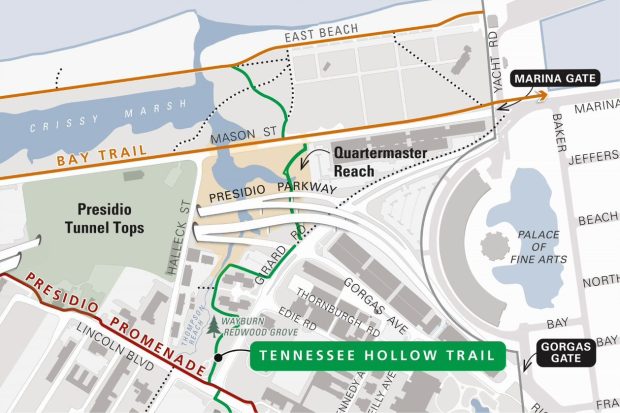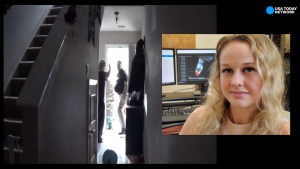For decades, the area was covered with asphalt, railroad tracks
and warehouses as part of an Army base in the shadow of the Golden
Gate Bridge.
But now a new project is transforming the landscape back to
wetlands, creeks and trails for birds, fish, crabs and other
wildlife — and for outdoor lovers from across the Bay Area and
the world.
Marking the most recent step forward in the decades-long effort
to turn back the clock along San Francisco’s waterfront to a more
natural state not seen since the 1800s, planners on Friday are
unveiling a new $23 million wetlands restoration project at the
Presidio. The project has converted seven acres next to Crissy
Field in an area adjacent to Presidio Parkway called Quartermaster
Reach.
“For so many years this was an industrial area, a part of the
Army,” said Genevieve Bantle, project supervisor for the Presidio
Trust, the agency overseeing the work. “The highway caused a
complete separation of the waterfront from the Presidio. This
project and others makes the Presidio whole again. We’re knitting
things back together that have been separated for a long
time.”
The Presidio opened in 1776 as a Spanish Army post overlooking
San Francisco Bay. It transferred to Mexican control in 1822, then
U.S. ownership in 1847.
The largest open space in San Francisco, the 1,491-acre site
became part of America’s national park system in 1994 after the
Army base closed and Congress transferred the land to the National
Park Service. The Presdio Trust, an agency Congress created, runs
most of the Presidio, and is responsible for restoring its historic
buildings and keeping the site financially self-sufficient through
rents and other revenues.
For the past 26 years, the landscape has been evolving. One
project at a time, historic military buildings dating back to the
Civil War are being refurbished by the National Park Service,
Presidio Trust and non-profit groups into offices, homes, lodges
and other uses. In other places, damaged landscapes are being
replanted and restored.
“The pandemic has shown us how critical access to nature is,
with the myriad of health benefits it provides for human beings —
especially in an urban environment,” said Laura Joss,
superintendent of Golden Gate National Recreation Area, which
includes the Presidio.
In the current project, which began construction a year ago,
workers took a creek that the Army had put into culverts and buried
underground generations ago and brought it back to the surface so
it now flows to the ocean naturally for the first time in more than
100 years. They built a new hiking trail that connects Crissy
Field, through the new wetland area, past the Presidio visitors
center to Inspiration Point, about 1.5 miles away, on the south end
of the park near the Presidio Golf Course. The trail is expected to
open by Dec. 18.
The
new Quartermaster Reach project is a 7-acre wetland and trail
connection to the wider Presidio area as part of the restoration of
San Francisco’s waterfront near Crissy Field. (Presidio Trust)�
The restored wetlands area looks muddy and barren now. But crews
are finishing planting 23,000 native plants, which should turn the
area green in the coming year as they sprout and provide habitat
for shorebirds, fish and crabs. Workers also put in structures with
oyster shells to attract native oysters back from the bay.
The adjacent 14-acre Crissy Marsh was restored in 2001, although
not as large as biologists had hoped due to the discovery of an
archeological site, and concerns from neighbors who wanted big
areas of Crissy Field open for recreation. The new wetlands area is
expected to help make up for the lost opportunity.
Just in the last few weeks, herons, egrets, killdeer and other
birds have flocked to the site. Small fish are turning up in the
reborn stream.
“When we bring water back to the surface, nature takes over.
The birds show up. The invertebrates come in. Plant life
flourishes,†Bantle said.
The area, which housed pavilions during the 1915 Panama-Pacific
Expo world’s fair, is being called Quartermaster Reach, after the
Army’s Quartermaster Corps, which stored food and other Army
provisions in warehouses there for decades.
Funding for the wetlands project came from Caltrans, which
upgraded the Presidio Parkway road system, along with the U.S.
Environmental Protection Agency, the National Park Service, the
Evelyn and Walter Haas, Jr. Fund, the Weeden Foundation and donors
to the non-profit Golden Gate National Parks Conservancy.
“This is an incredible gift to this region, and builds on the
work that began in 2001 with the restoration of Crissy Field and
Crissy Marsh,†said Christine Lehnertz, president and CEO of the
Golden Gate National Parks Conservancy.
An even larger project nearby continues. That work, called
Tunnel Tops, will be a new 14-acre park on top of two Presidio
Parkway tunnels. When finished by the end of 2021, it will feature
trails, gardens, a campfire circle, community plaza and trees. It
will link Crissy Field to the Presidio’s Main Post, parade
grounds and visitors center. That connection was severed more than
80 years ago when the road to and from the Golden Gate Bridge,
formerly known as Doyle Drive, was built, splitting the landscape
in half.
 Crews
Crews
put the finishing touches on a $23 million project to convert
asphalt parking lots at the former Presido Army base to a natural
wetland on Nov. 20, 2020 as part of a restoration of San
Francisco’s waterfront near Crissy Field. (Photo: Cris Gebhardt,
Presidio Trust)


















